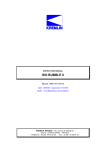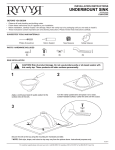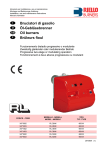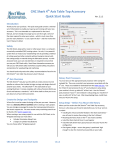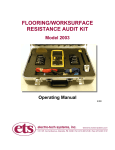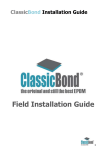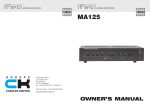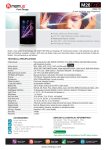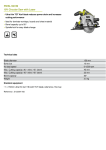Download Ezystone Installation Manual v7
Transcript
EZYSTONE WORKSURFACES Installation & Maintenance Instructions 1. Tools Required Worktop Edge Finishing Kit Pack 1 - 100mm Velcro Backing Pad Pack 2 - 100mm Diamond Dry Cut Velcro Discs (100 Grit Yellow) (200 Grit Orange) (800 Grit Green) (1500 Grit Turquoise) (10000 Grit Buff Pad Black) Diamond Blade - 150mm Diameter Blade – 20mm Bore Diamond Holesaw Bit - 35mm Standard Holesaw Bit -35mm Masonry drill – 6mm 2 Part Adhesive Clear Silicone Recommended additional tools – Angle grinder, clamps, square 2. Unpacking and Preparation Like all granite & quartz worktops Ezystone must be stored, handled and transported with care. It must be stored by being laid flat and fully supported along its length. It must never be thrown or dropped. It must be stored in a dry well ventilated space with constant temperature and humidity. It is recommended that two people are required to carry the worktops & sink modules. Please observe the normal manual handling rules when lifting or moving. The worktops should be carried on their edge and particular care taken when handling the sink modules. The worktop should be removed from its outer case in a dry and stable environment, where the humidity is constant before commencing installation. Treat the product with care when removing it from it’s packaging to protect the polished surfaces. If storing the worktop, remember to lay it flat and ensure it is fully supported. Never stand it on either the long or short edge. “All work surface materials should be checked for any damage, faults and colour consistency prior to installation. Any claims after installation relating to damage, faults or inconsistency are not covered by the product warranty.” Please ensure the packaging is disposed of in a safe environmentally friendly way. 3. Cutting The following equipment is required to complete this section: - Circular saw - Clamps - Square - Rail - Masking tape - Tape Measure - Dust Mask Place the worktop on the bench ensuring there is plenty of room to work around the product. Using a tape and a pencil mark the worktop at the required length. Clamp the worktop down securely ensuring it is stable. Use a circular saw to make the cut in the worktop at a steady controllable pace. NOTE: Ensure the diamond blade is used for cutting the worktops. To prevent splintering it is recommended not to push too hard onto the worktop. Depending on the sharpness of the blade being used, the cut should be made in one pass. NOTE: It is advisable to use extraction where possible to reduce the amount of dust generated. It is best to cut outside where possible. 4. Edging The following equipment is required to complete this section: - 2 Part Adhesive & spatula - Knife Blade Ensure the end of the worktop and edging strip are clean. Mix the 2 part adhesive and hardener together following the manufacturers instructions. NOTE: The 2 part adhesive mix will set quickly and should be used immediately. Apply the 2 part adhesive with a spatula to the quartz edge of the worktop and fit the edging strip. Press fiirmly into place rubbing the edging strip from side to side until the adhesive oozes out from the edges. T h e edging strip should sit just proud of the worktop surface and front edge by up to 1mm, as this can be sanded back later. Before the adhesive has fully cured (no longer tacky to touch but not fully set), scrape away the excess from the top edge of the worktop using a knife blade. NOTE: Before sanding a chamfer on the edge, wait for the adhesive to fully set. This could be around 10 20 minutes depending on environmental conditions. A chamfered edge should now be sanded into the edging strip. Please refer to the sanding & finishing section. 5. Sanding and Finishing The following equipment is required to complete this section - Flex/ Orbital Sander - Water Spray Bottle - Worktop Edge Finishing Kit Pack 1 - 100mm Velcro Backing Pad Pack 2 - 100mm Diamond Dry Cut Velcro Discs (100 Grit Yellow) (200 Grit Orange) (800 Grit Green) (1500 Grit Turquoise) (10000 Grit Buff Pad Black) A chamfered edge should now be sanded into the top and front vertical edge of the edging strip. This should replicate the chamfered edge on the front of the worktop. Apply water to the edging strip before sanding begins and regularly throughout the sanding process as the pads are used. Note. During the sanding process water should be applied before a stage begins. This can then be wiped away using a cloth at the end of each stage. The water ensures the edging does not scorch and cleans away any grit particles. Fit the velcro backing pad to the flex sander. Starting with the 100 Grit pad work along the full length of the edging strip, moving from side to side creating the chamfered edge. This pad will remove approx. 90% of the material and form the finished shape of the chamfer. Use the glue line as a marker with the aim of this forming the upper angle of the chamfer, where it is less visible. Work through the sequence of pads in stages, applying even pressure, finally using the 10000 Grit pad to finish off. Note. Do not sand the finished face of the edging strip or the worktop under any circumstances, only the chamfer should be sanded/finished. Ensure a mask and eye protection are worn, and use suitable dust extraction 6. Joining The following equipment is required to complete this section, please note that worktop bolts are not required. - 2 Part Adhesive, spatula, masking tape With the worktop cut to length it can be joined to the side or front edge (in a corner application) using the 2 part adhesive, as used when applying the edging strips. You should dry fit the tops to ensure that you are happy with the levels and angles before fixing permanently. Clean both surfaces prior to joining. We recommend that masking tape is used on the top of the worktop at the joining edges. This will stop excess adhesive getting onto the worktop. Pull the worktops 2-3mm apart and apply the 2 part adhesive with a spatula to the edge of the worktops and fit together. Press the worktops firmly together until the adhesive oozes out from the edges. Before the 2 part adhesive has fully cured (no longer tacky to touch but not fully set), scrape away the excess adhesive from the top edge of the worktop using a knife blade. NOTE: Under no circumstances should the finished face of the worktop be sanded. However, when making an end to side joint it may be necessary to lightly roughen the polished edge in that area to enable the adhesive to fully bond. To attach the worktops to the cabinets at the same time, apply a bead of silicon or adhesive to the cabinet tops just prior to gluing the joint 7. Hob and Sink Installation The following equipment is required to complete this section: - Sink or Hob template / dimensions - Drill - Circular Saw - Flex/Orbital Sander - Jigsaw - Diamond Blade – 150mm Diameter with 20mm Bore - 35mm Diamond Holesaw Bit for standard drill - 35mm Holesaw Bit for wood - 6mm Masonry Drill Mark out the cutting area for the Hob or sink; using a tape measure, pencil and masking tape. Use a 6mm masonry drill to make a pilot hole for the diamond holesaw, and then again a hole right in each corner to help the removal of quartz later. Use a 35mm diamond holesaw to create a hole in each of the 4 corners through the Quartz section only. NOTE: The hammer setting on the drill should be selected. Continue to drill through the poplar ply section of the top using a standard 35mm Holesaw bit. NOTE: The cutting process takes less time and is made easier by using the two types of Holesaw. Using the circular saw with a diamond blade, cut along the guidelines between the holes using the rail/guide to ensure a straight edge. Depending on the sharpness of the blade being used, the cuts should be made in one pass. Once the cut out is complete, use a jigsaw to cut way any ply notches in the corners. Smooth off any burred edges or notches using the flex sander. The sink or hob can now be fiitted as normal using the tape and clips provided with them. The worktop should be handled with extra care once the cut out has been removed. 8. Undermount Sink Installation The following equipment is required to complete this section: - Clear Silicone The undermount sink worktop modules are supplied with a sink & tap cut out and draining grooves already in place. Measure and mark the worktop module to the required length. NOTE: Before cutting the module to size ensure the sink bowl fits within the base cabinet cavity. Cut the worktop as required following the cutting instructions in section 3. The worktop section should be fitted in place before the undermount sink is secured. Ensure the surfaces are clean and then secure the sink to the underside of the worktop using silicone sealant. NOTE: Use packing under the sink until the silicone is fully set. Important: If installing a waste disposal unit, we recommend additional permanent support for the undermount sink. This can be in the form of a cradle or additional fixing brackets. Remove any excess silicone from the stainless steel bowl using soapy water and a spatula, before allowing to cure. Do not use the sink for 24 hours after installation to allow the silicone to set. NOTE: Clean away any excess silicone using soapy water. 9. Upstand Installation The following equipment is required to complete this section - Circular Saw or Angle Grinder - 2 Part adhesive glue & hardener - Clear Silicone Use a pencil and tape measure to mark where the upstand needs to be cut. Use a square and straight edge to make the line across the upstand. Cut the upstand using an angle grinder or circular saw. Once this has been completed, use the Edge Finishing Kit to smooth the edges of the upstand. Apply Silicone to the rear of the upstand and worktop then fiit into place. Remove any excess sealant before it sets. NOTE: Under no circumstances should the finished face of the upstand be sanded. When joining two pieces of upstand together, apply a small bead of worktop 2 part adhesive to both edges and push the upstands together until excess adhesive oozes out of the joint. Remove any excess adhesive with a knife blade before it has fully cured (no longer tacky to touch but not fully set) 10. Worktop Fitting – General Points • Under no circumstances should the finished face of the worktop be sanded. Only the chamfer should be sanded during installation. • The worktop face is supplied finished and care should be taken whilst installing to avoid scratches. • Joint adhesive can be re-applied if any pulls away from the joint when removing the excess. • Worktops can be scribed to the wall if required. • Ensure the worktops are level before final fixing. • To hide any imperfections at joins on black worktops use black beeswax 11. Care & Maintenance • Wipe worktops using soapy water. For stubborn marks use Astonish cleaner or a similar product on a normal cloth/duster to remove. • No abrasive cleaners should be used. • The Ezystone worksurface is scratch resistant but not scratch proof. We recommend the use of a chopping board when cutting. Do not cut directly onto the surface. • Do not place hot pans directly onto the surface of the worktop. Worktop trivets or hot rods should be used where applicable • Do not leave spills on the work surface. Always wipe away immediately. • In particular avoid chemicals such as nail varnish remover, acetone, chlorine, oven & drain cleaners. V7











